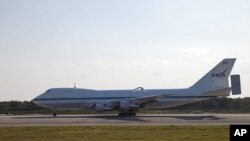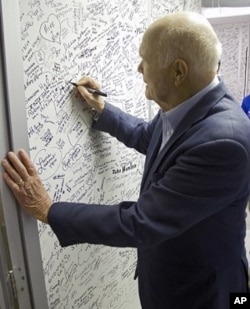Before NASA's space shuttle Discovery was retired, it
- Completed 39 missions.
- Spent 365 days in space.
- Orbited the Earth 5,830 times.
- Traveled a total of 238,539,663 kilometers.
NASA's space shuttle Discovery has traveled more than 238 million kilometers in space, and the now retired orbiter has roughly 1,000 kilometers more to go before its final stop. It will leave the Kennedy Space Center on April 17, bound for a museum.
One Last Flight
It was a little more than a year ago that the space shuttle Discovery lifted off from the Kennedy Space Center on its final mission.
The 28-year-old orbiter will take off from the southern state of Florida one last time. But for this voyage, it will not be blast off a launch pad. Instead, it will hitch a ride on the back of one of NASA's specially outfitted Boeing 747 jumbo jets.
Valerie Neal is a space history curator at the Smithsonian National Air and Space Museum here in Washington. Her dangling earrings in the shape of space shuttles are only one indication of her excitement about Discovery's final flight.
"We're very excited about that because Discovery will be flown on top of a 747 carrier aircraft, and it will do a flyaround here in the metropolitan [Washington, D.C.] area so that people around Washington will be able to see this very unusual sight," Neal says. "It will land, and then it will go off to a private part of the airport to be offloaded from the carrier aircraft."
Inside the Vehicle Assembly Building, or VAB, at NASA’s Kennedy Space Center in Florida, an overhead view shows space shuttle Discovery in high bay 4 with the Astrovan alongside. The Astrovan was used to transport astronauts to Launch Complex 39 for space shuttle missions. April 5, 2012 (NASA Photo)
Discovery's Unveiling
The Air and Space Museum is one of the most visited museums in the world, with its main location in downtown Washington, near the city's grand monuments and attractions. The museum's Udvar-Hazy annex alone attracts more than a million visitors each year.
But as the museum gains one famous piece, it will lose another. The world's first space shuttle, Enterprise, has been part of the Smithsonian's collection since 1985. Discovery will replace Enterprise, and that shuttle will catch a piggyback ride on the 747 to New York City, where it will go on display at the Intrepid Sea, Air & Space Museum.
Smithsonian curator Valerie Neal explains that Enterprise is a test vehicle that never flew in space, so it does not have the same rich history as orbiters such as Discovery.
"It [i.e., Discovery] will look just like [the shuttle atmospheric test vehicle] Enterprise does, except instead of being white and black and looking brand new, it's more beige and gray," say Neal. "It looks like it's been to space and back 39 times, and that's how we want it to look."
At NASA's Kennedy Space Center in Florida, space shuttle Discovery arrives outside Orbiter Processing Facility-1 (OPF-1) after stopping for a unique "nose-to-nose" photo opportunity outside OPF-3 with shuttle Endeavour. (NASA Photo) Shuttle Retirement
NASA astronaut Dan Burbank, who has flown on Discovery and is now on the International Space Station, says the 30-year-old shuttle fleet has earned its retirement.
"It brought up some spectacular observatories into space and some satellites, and it helped build this nearly 1,000,000 pound [i.e., almost 453,600 kilograms] world class laboratory [i.e., the International Space Station] that we have the great privilege of working and living aboard for six months," Burbank says. "I think having the space shuttles in museums where people can come and see them and learn about them and learn about the wonderful technology, I think it'll be a good thing."
Rounding out the retired shuttle fleet are Endeavour and Atlantis, which will go to California and Florida. NASA's two other shuttles, Challenger and Columbia, were destroyed in flight, killing all astronauts on board.
The U.S. space agency retired the shuttle fleet last year to focus on developing the next generation of spacecraft that will travel beyond low earth orbit.










